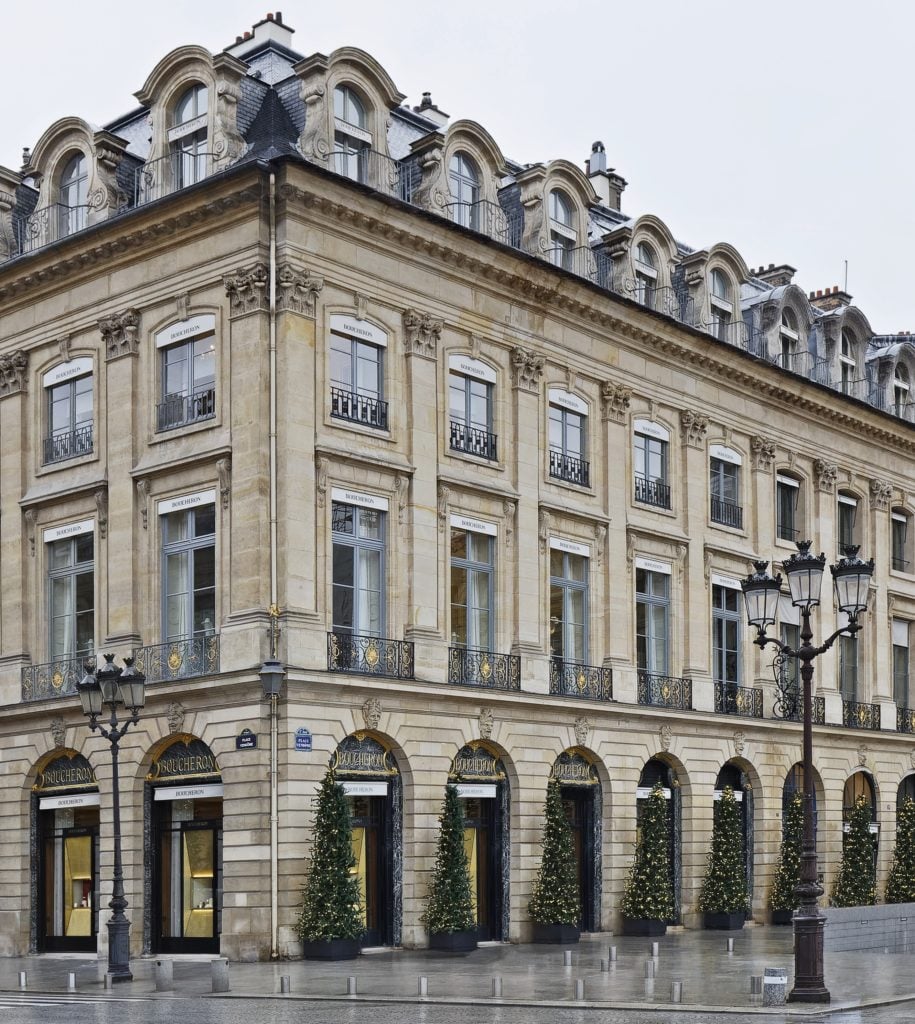Boucheron is making a resounding return to the heart of Paris this month with the reopening of its historic boutique located at 26 Place Vendôme.
Giving Boucheron an optimal perch to begin a new chapter in its 160-year history, the sophisticated venue is a hôtel particulier known as the Hôtel de Nocé that has emerged from 18 months of renovation courtesy of Kering, the luxury group that acquired the jeweler in 2000.
For Kering—whose luxury brands includes Saint Laurent and Gucci—the goal was to reposition Boucheron in the high-jewelry sector, where the maison has “absolute legitimacy,” according to the company’s chairman François-Henri Pinault.
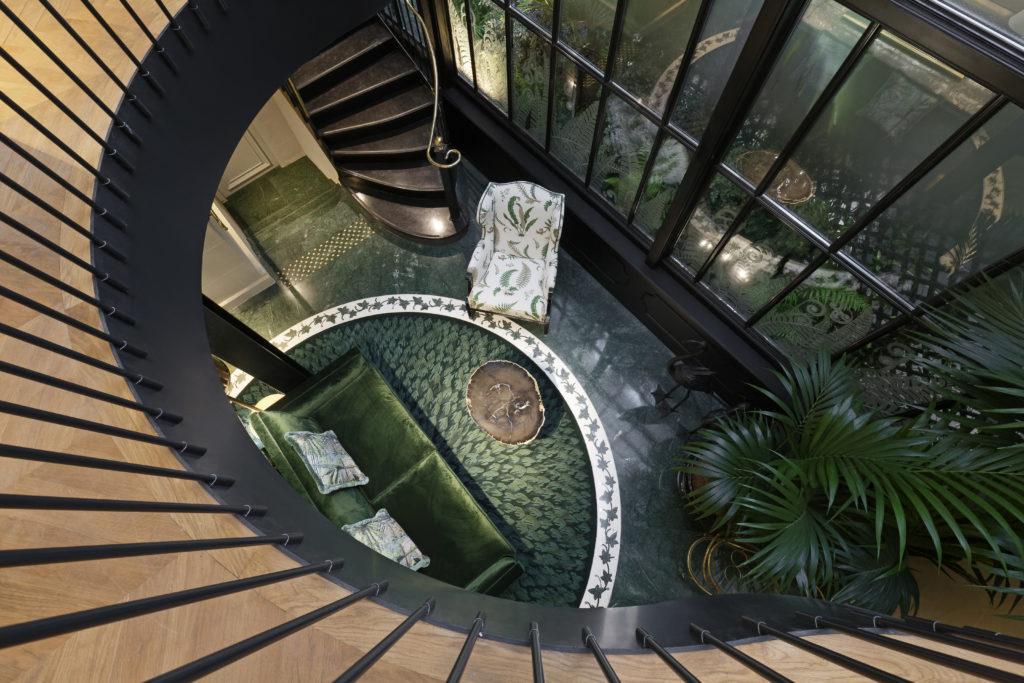
Courtesy of Boucheron.
A transcendental experience is at the heart of the connection that luxury houses today are seeking to establish with their clients, and one that Boucheron is well positioned to provide here now that the veil of secrecy has lifted over the site’s construction. Clients, friends, and visitors can now savor a splendid environment as they step inside the Hôtel de Nocé, built in 1717 and named after its first owner, Charles de Nocé, the premier gentilhomme to Philippe II, Duke of Orléans, who served as Regent of France until the young king Louis XV had come of age.
“It was fundamental to revive the original spirit of the Hôtel de Nocé through a renovation that respected its history and heritage,” said Boucheron chief executive Hélène Poulit-Duquesne. “All our history, all our savoir-faire, and all our values are united here.”
To set the stage for the future, Boucheron has mined its past to give new life to what has been home to the family-owned jeweler since 1893. Seamlessly marrying different styles and epochs across 30,000 square feet, the site respects its classic French heritage while bringing modernity to the fore.
Giving New Life to the Hôtel de Nocé
Except for its historically protected classical façade, 26 Place Vendôme has now been completely transformed to restore its palatial grandeur.
Originally a private home, the building was converted into a rental apartment building in 1814, resulting in the addition of several mezzanine levels to its interior architecture to sacrifice its soaring ceiling heights in the interest of gaining square footage.
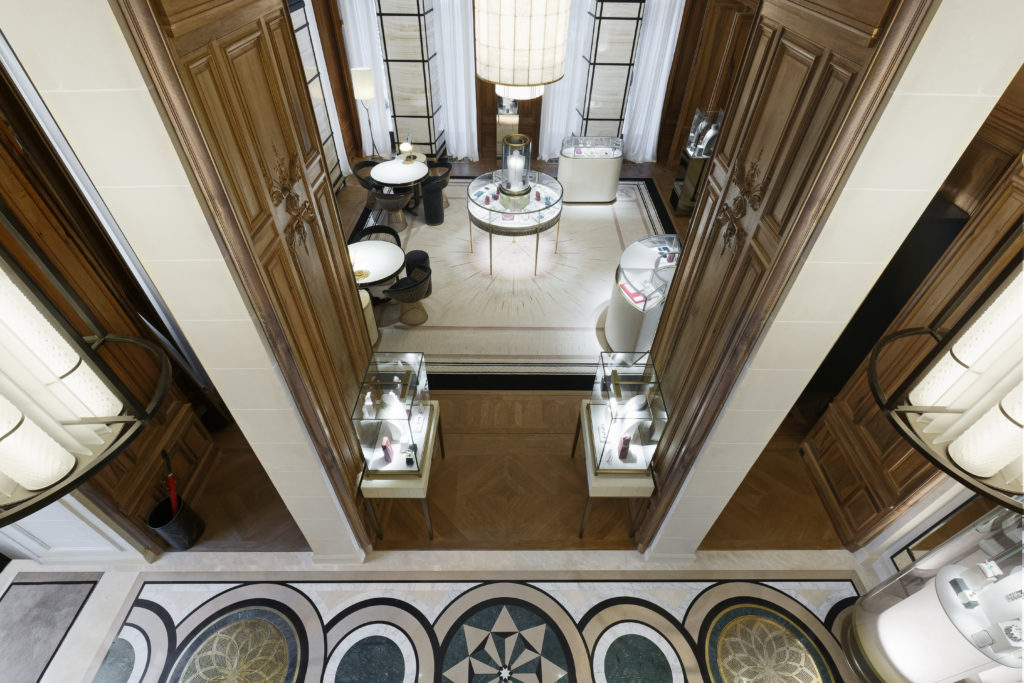
Courtesy of Boucheron.
In 1893, when Frédéric Boucheron, founder of the maison, set up shop here, he was the first jeweler to venture onto the Place Vendôme. Until then, jewelers preferred the Opera district or the intimate salons of the Rue de la Paix to the open space of the large square built in 1685 by order of the French king, Louis XIV, as part of an urbanization plan to create wide spaces to contrast with the narrow, winding streets of old Paris.
Home to the Boucheron family home and the epicenter of the house’s savoir-faire, the building was acquired by Kering in 2010. The site was designated a French historic monument in 1930, so its renovation could only be performed under the supervision of a state-approved architect.
Enter Michel Goutal, chief architect of France’s historic monuments, who was tasked with the delicate and prestigious project. Working with a team of skilled artisans specializing in bronze, wrought iron, gypsum, and marble, Goutal sought “to rediscover the internal logic of a building modified by history, and return to a highly structured concept enabling the rooms to retain their character,” Boucheron told artnet News.
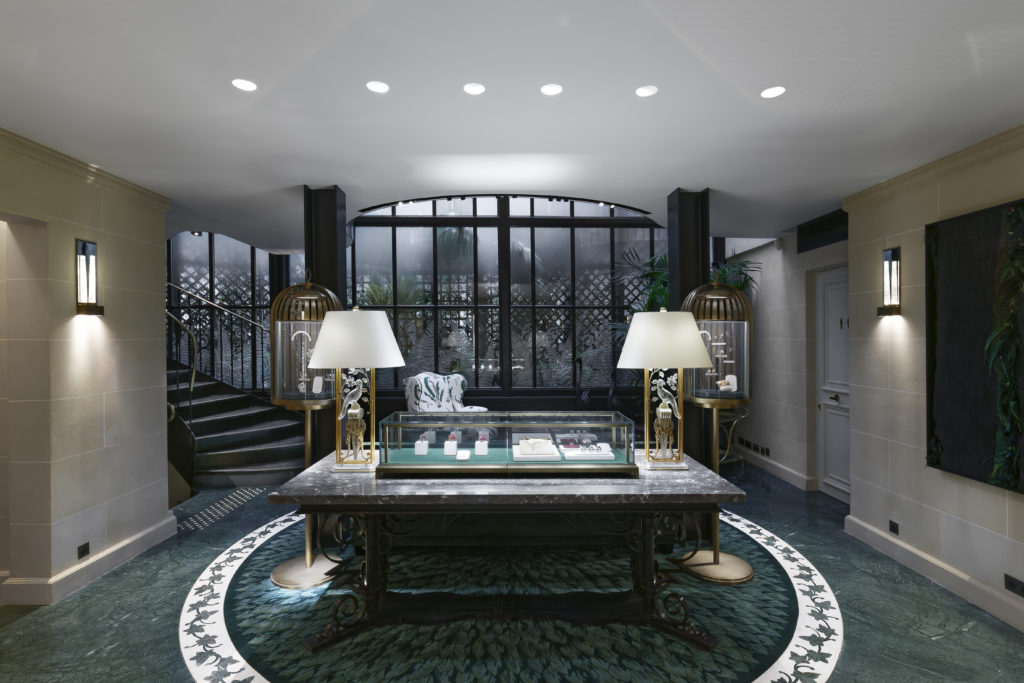
26 Vendôme jardin d’hiver. Courtesy of Boucheron.
Nearly all the mezzanine levels were removed, revealing a glass-roofed winter garden that opens the site up to new light and air. The quest for cool, northern daylight—the same light that illuminates the Impressionists’ paintings of the same period—was the main reason Frédéric Boucheron moved here 125 years ago. That light now floods the interiors, bathing the reception salons and a majestic staircase that winds up, like a spine, through the structure.
The main entrance on the Place Vendôme, dating from the 1970s, today welcomes the visitor to the main salons via a stunning, marble-mosaic floor under double-height ceilings. A second entrance has been opened on the Rue de la Paix, leading to the staircase that serves to connect the different métiers and workshops that Boucheron has now assembled under the same roof, namely conception, crafting, showroom, and sales.
“All our métiers have their place here, from design through manufacture to retail,” Poulit-Duquesne said. “In this family home, visitors will discover a new jewelry experience, since they will be welcomed as friends more than as clients.”
The Spirit of La Castiglione
The intimate ambiance of the red lacquer walls of the Salon Chinois remains intact, including a secret passage through which a mistress selecting jewels with a patron could be whisked away discreetly if his spouse were to enter the boutique unexpectedly.

Italian Virgiana Oldoini (1837-1899), countess of Castiglione. Photo by Pierre Louis Pierson. (Photo by Apic/Getty Images)
One such famous mistress was the intriguing Virginia Oldoini, Countess of Castiglione, a paramour of Emperor Napoleon III who was reputed to be the most beautiful woman of Europe, and who lived here in a mezzanine apartment in a self-imposed exile. The apartment was laden with heavy black drapes, reportedly kept drawn all hours, Oldoini would only venture outside under the cover of night to hide the fading beauty of her later years.
The spirit of La Castiglione can now roam freely in the cream-and-gold-colored Salon des Fiancés, the new Bridal shop over which a “draping” glass chandelier is suspended in homage to Frédéric Boucheron’s father, a drapier by trade whose influence is evoked by the grosgrain motif in Boucheron’s collections.
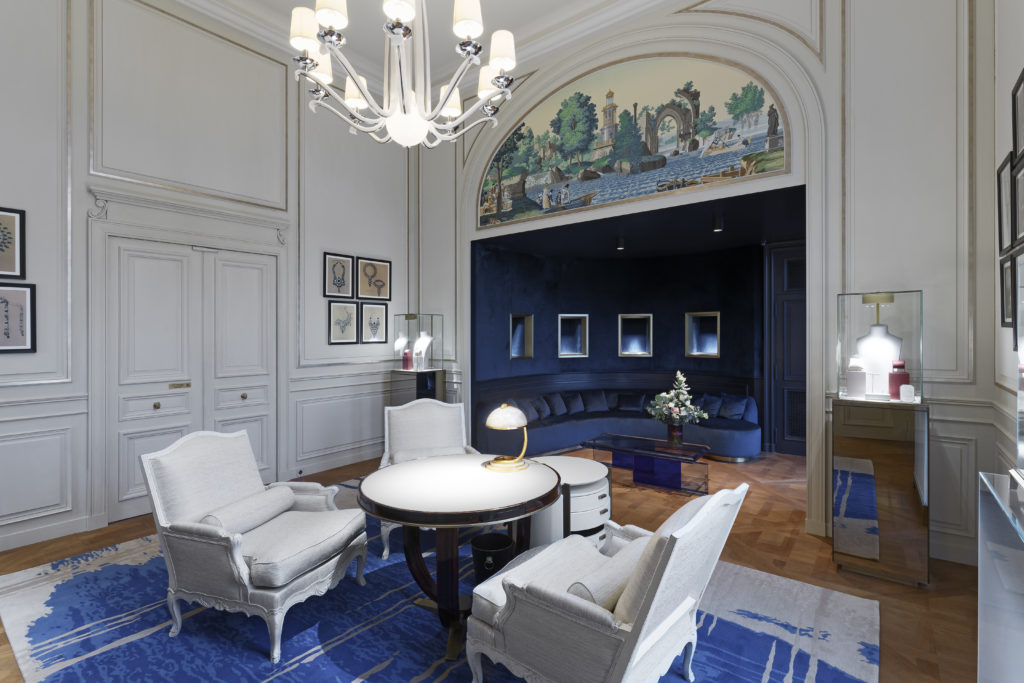
26 Vendôme Salon de créations. Courtesy of Boucheron.
The blue Salon des Créations will now allow Claire Choisne, Boucheron’s creative director, to work directly with clients using archive drawings, some of which hand on the walls. An interactive screen in an adjacent hallway features vintage photographs of some of Boucheron’s notable clients, including the divine Castiglione.
A Bespoke Interior Decor
The interior decoration and attention to detail that gives this site both its authenticity and its welcoming feel are the work of the French interior designer, Pierre-Yves Rochon.
“Rochon’s challenge was to give this historic address the character of a modern family home,” Poulit-Dusquene said. “The décor of each room is a carefully curated blend of contemporary design, works of art and vintage finds, as if each generation had left its own imprint on the house.”
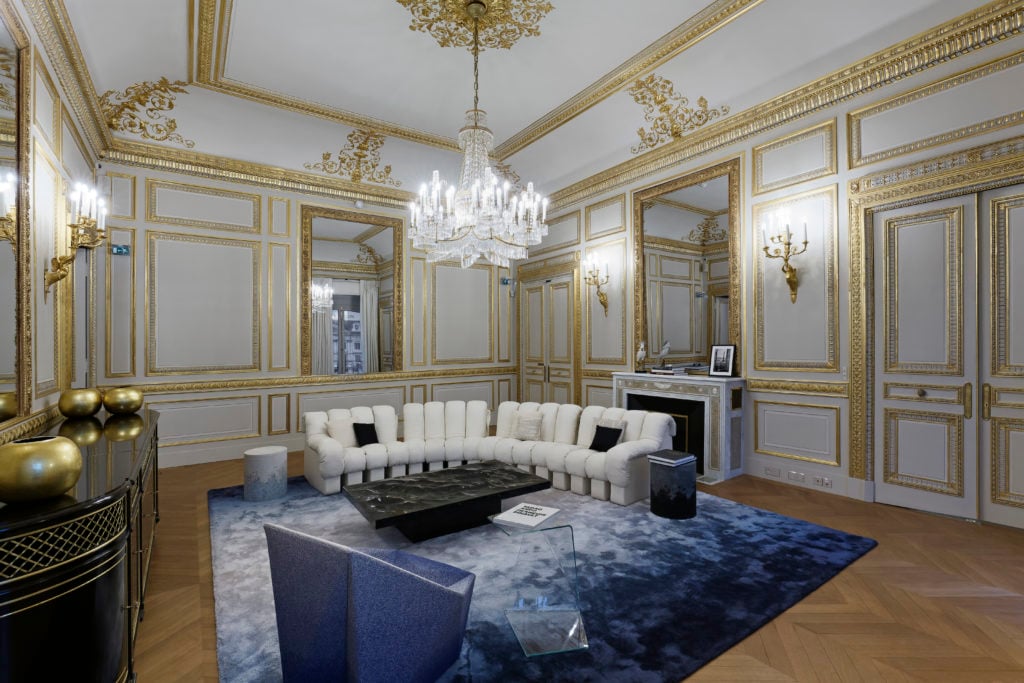
Vendôme salon, appartement. Courtesy of Boucheron.
Many of the decorative pieces, namely the spectacular light fixtures, were custom-designed by Rochon, including the rock-crystal chandelier that hangs in the grand salon surrounded by 1930s furniture and 19th-century walnut paneling.
Rochon’s eclectic décor contributes to the singularly unique feel of a contemporary interior where some of the best craftsmen working today have left their signature, creating an experience that breaks with retail convention and makes the client feel both privileged and right at home.
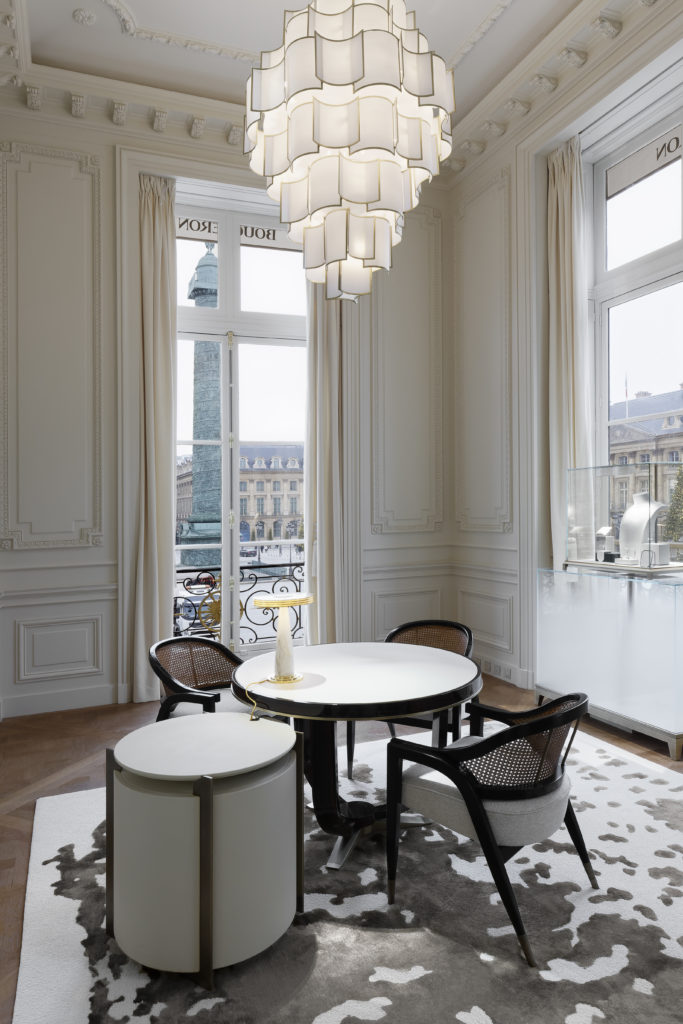
26 Vendôme Salon des lumières. Courtesy of Boucheron.
The top floor has been transformed into a luxurious apartment equipped for overnight guests, with sweeping views of the Place Vendôme, and attended by a dedicated butler from the Hôtel Ritz, for a truly immersive experience.
